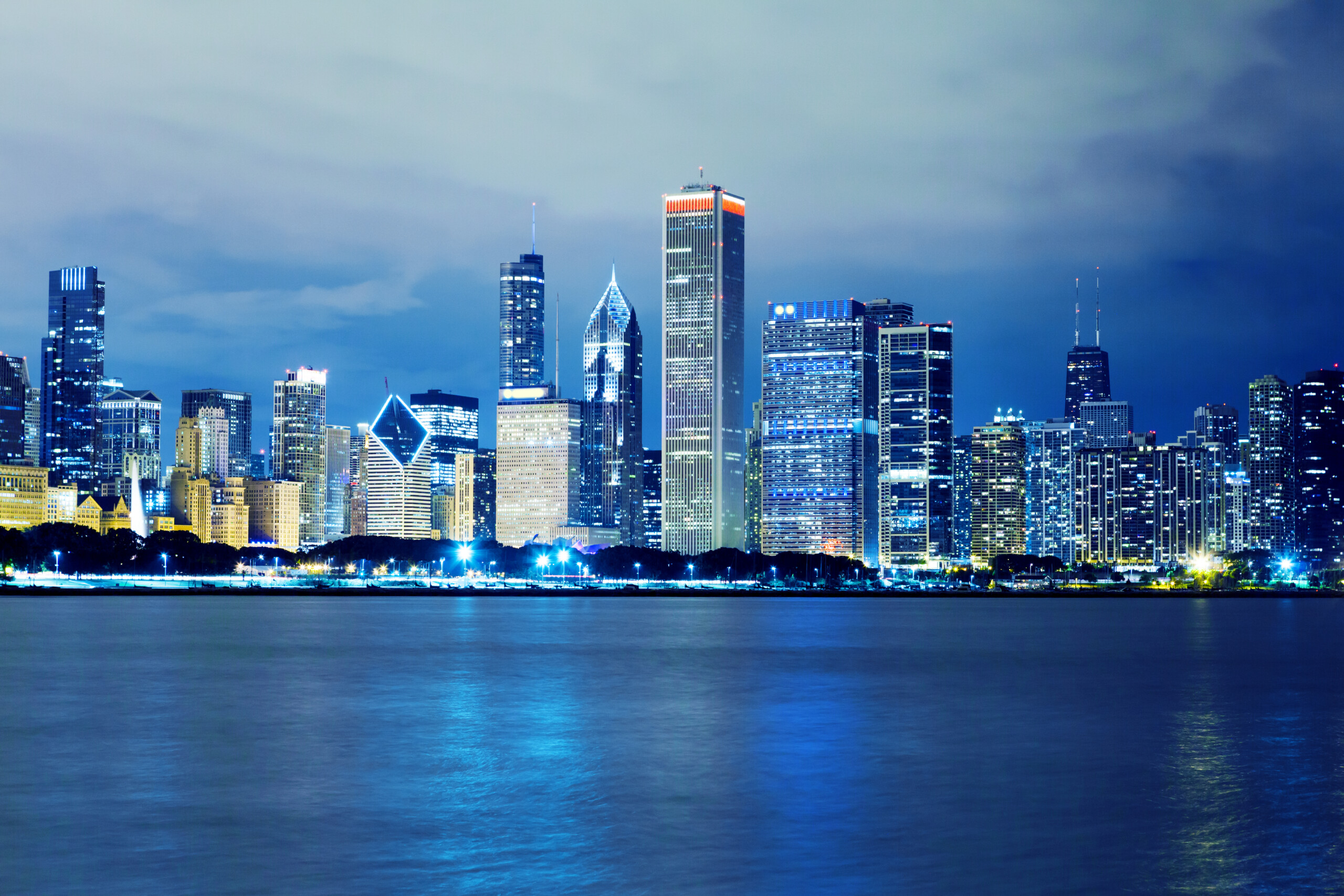
American cities are full of amazing and diverse architecture. The landscape of landscape of Los Angeles differs greatly from that of Las Vegas which differs greatly from that of New Orleans which differs greatly from that of New York… You get the picture. But there is one city that packs such a tour de resistance, and that, of course, is Chicago. And in this issue Destinations blows into the Windy City to explore.


Chicago has long been a laboratory for architectural innovation and experimentation. Its skyscrapers, museums, theaters, bridges, homes, schools, houses of worship, and parks are spectacular. And unique. A great example of this is the Monadnock Building. Built in two phases, it demonstrates a visible shift from load-bearing construction to skeleton frame construction—a change that happened throughout the city in the late 19th Century. Traditional ornamentation adorns the south half of the building, but the north half is boldly stripped-down, bucking trends of the time and previewing the Modern style to come.
But Monadnock is only one example of great architecture in the city. There are, literally, dozens of examples – all different in form and function– that make Chicago stand out and earn the distinction of being one of the best architectural cities. Here are just a few…
150 North Riverside

Gravity-defying 150 North Riverside has already taken its rightful place among Chicago’s architectural and engineering wonders. Architects from Goettsch Partners and engineers from Magnusson Klemencic Associates (MKA) took on the challenge to squeeze what would become a nearly 1.5 million square foot building onto a two-acre compact site.
With such a small footprint of buildable space at street level, the architects and engineers needed to develop an innovative solution that still allowed for large rentable office floors to generate income. The result is a 54-story skyscraper that defies typical structural logic. It’s common for tall buildings to have a wide base that gives stability to the foundation and then narrows at the top—think of the John Hancock Tower, for example. But it’s quite unusual for a tall building to be narrower at the bottom and widen at the upper floors. Yet, that is exactly the type of structural gymnastics Goettsch and MKA pulled off.
The building rises on a very small base, which slopes outward at an angle for the first eight stories, then widens to nearly the full width of the site. To accomplish this feat, the designers chose a core supported structure, a massive central concrete “spine” that holds the elevator core and also transfers the load of the upper floors down to the foundations. Caissons were drilled more than 110 feet below grade level and sunk 5 feet into Chicago’s bedrock to provide a stable foundation in Chicago’s swampy soil. During construction, the building’s location along the river was considered an asset, rather than a liability, when 81 floating barges were tied together to hold a 2 million pound crane that lifted the giant steel trusses. In addition, the largest and longest hot-rolled steel beams ever used in the U.S. allowed the building’s width to splay out from 39 feet to 120 feet.
111 South Wacker

When faced with complicated site and structural challenges, architect Jim Goettsch and his team developed a smart and creative solution. The result at 111 South Wacker is an award-winning Gold LEED (Leadership in Energy & Environmental Design) certified building.
The original site of 111 South Wacker once hosted the magnificent US Gypsum (USG) building. The structure was turned at a 45-degree angle toward the corner of Wacker and Monroe. When it was demolished in 2003 to make way for the John Buck Building, it left behind a problem to be solved. The original caissons were angled irregularly and therefore could not have supported the proposed structure. Not only that, next door, a 15-story building blocked precious views, which meant the occupiable structure needed to be 120 feet from the ground. To solve the problem, Goettsch put a parking garage on the first seven floors, but this is no ordinary parking garage. Its dramatically-lit, spiraling ramp reflects down into the 44-foot lobby space beneath it.
The lobby’s stepped ceiling and marble and granite floors, laid in radial patterns, extend the spiral motif and it doesn’t end there. The spiral pattern continues onto the pavement outside the building, and non-reflective glass creates an almost invisible barrier between its interior and exterior space. As you walk through the lobby, it feels as though the building is radiating both upward and outward.
190 S. LaSalle

This building’s austere masonry facade blends in well with its similarly clad neighbors. The coordinated exteriors make the street both grand and a little intimidating to behold. But while 190 South LaSalle intentionally blends in at street level, it makes quite a statement along the skyline. Its green gabled roof is distinctive. This building does a brilliant job of optimizing both ways it is viewed: as an unassuming structure from the street and as an eye-catching tower in the distance.
Designed by architects Philip Johnson and John Burgee, a Chicagoan, 190 South LaSalle adopts the visual language of earlier Chicago buildings but supersizes its decorative elements to add a touch of drama and fun. This is a common characteristic of Postmodern buildings—oversized scale combined with over-the-top symbolism and in-your-face colors—and depicts the architectural freedom that flourished in the 1980s and ‘90s. This style was an explicit response to the strict precepts of the International Style, epitomized in Mies van der Rohe’s steel and glass structures.
Philip Johnson himself had been a champion of the International Style but famously “changed his mind.” In the 1980s he began designing buildings that used traditional materials and made explicit contextual references both to the past and to neighboring buildings. For 190 South LaSalle, Johnson chose to reinterpret the gabled roof of Burnham & Root’s 1892 Masonic Temple. The Masonic Temple originally sat a few blocks away at the corner of Randolph and State but was demolished in 1939.
225 N. Columbus

From the moment it appeared on the Chicago skyline, the Aqua Tower has earned numerous awards for design excellence. However, it hasn’t kept all the glory for itself. It’s fair to say Aqua is a star-maker, with its 2009 completion putting the city’s newest neighborhood, Lakeshore East, on the tip of everyone’s tongue.
The Tower’s design is a brilliant new approach to the problem long ago identified by Louis Sullivan—how to create an aesthetic for a functional tall building. The basic structure is a standard, modern box. But Jeanne Gang and her firm, Studio Gang, surrounded this box with slow-rippling, white concrete balconies, giving the skyscraper a sculptural quality.
Each individual balcony is unique in size, shape and protrusion, allowing residents to chat with neighbors above or below. The balconies also help to break up wind vortices, minimize wind shear, shade neighboring apartments and prevent birds from colliding with windows. Each balcony is part of a greater floor slab. Contractors used GPS coordinates to precisely pour each of the 82 designs. Building Aqua was a feat of engineering.
Situated next to Lake Michigan in Lakeshore East, the building’s water motif connects residents and visitors to the city’s most remarkable natural landform. Also paying homage to the Midwest’s natural beauty is Gang’s decision to make the Aqua Tower planet-friendly, through rainwater collection systems, heat resistant and fritted glass, and energy-efficient lighting.
875 N. Michigan

Of course, 875 N. Michigan Avenue is the granddaddy of all. No list of Chicago architectural wonders would be complete without it. This 1,499-foot skyscraper’s groundbreaking engineering helped to make buildings taller than 100 stories—a new possibility—and freed skyscrapers to come from their traditional rectilinear shapes.
Skidmore, Owings & Merrill chose a bold form for the building. The tapered rectangular tube—with giant trusses on each of the four sides—doesn’t hide how the building stands up. The X-bracing on the building’s exterior enables it to resist wind loads. The lateral load-resisting system also reduces the need for internal columns, opening up the building’s interior and increasing available floor space.Engineer Fazlur Khan’s idea of the “trussed tube system” was an important stage in the development of the skyscraper. This design made it possible to build to unprecedented heights.
The original plan called for two buildings to be built on the site. But the private Casino Club just east of the site refused to sell its lot to the developers. A smaller site meant a tight squeeze, and architect Bruce Graham recognized that it wasn’t going to be big enough for the two planned towers. Upon further economic analysis, the team determined that a trussed, single tower was more cost effective. Plans were changed.
Despite a financial crunch that prompted the building to change ownership from Jerry Wolman to John Hancock in the midst of construction, it was completed in 1968. Today, the building’s tenants include a mix of residential apartments, retail and office spaces, and a 94th-floor café and observatory where visitors enjoy a 360-degree view of the city. On hot summer days, the building’s street-level plaza serves as an oasis in the middle of the city, complete with a lush garden and a waterfall.
(Source: Chicago Architecture Center)


